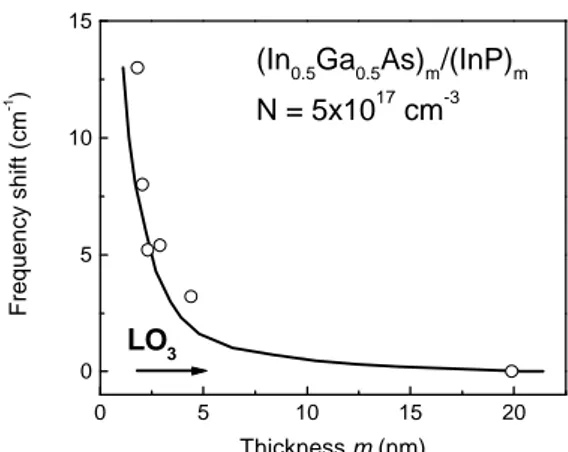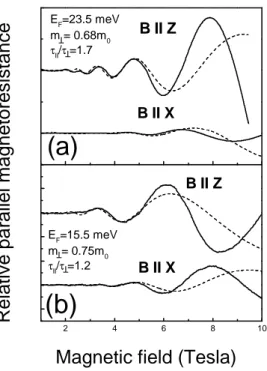Brazilian Journal of Physics, vol. 36, no. 3B, September, 2006 905
Evidence of the Miniband Formation in InGaAs/InP Superlattices
Yu. A. Pusep1, A. de Giovanni Rodrigues2, J. C. Galzerani2,
1Instituto de Fisica de S˜ao Carlos, Universidade de S˜ao Paulo, 13560-970 S˜ao Carlos, SP, Brazil. 2Departamento de Fisica, Universidade Federal de S ˜ao Carlos, CP 676,13565–905, S˜ao Carlos, SP, Brazil
D. Comedi, and R. R. LaPierre
Centre for Emerging Device Technologies, McMaster University, Hamilton, Ontario, L8S 4L7, Canada
Received on 8 December, 2005
The formation of the miniband electron energy structure was explored in dopedInGaAs/InPsuperlattices with different periods. The analysis of the Raman data allowed us to conclude that in spite of the defect structure of the layers constituting the superlattices, their super-periodicity was well defined. The quantitative proof of the conditions for break-down of the Raman selection rules is presented: the emergence of the selection rules of the coupled plasmon-LOphonon vibrations was demonstrated to occur due to the increase of their coherence lengths. In addition, the expected anisotropy of the effective electron masses was found by high-field magnetoresistance.
Keywords: Superlattices; Plasmons; Raman scattering
InGaAs/InPheterostructures present an important class of semiconductor materials with possible applications in infrared optoelectronics. Moreover, a largeg-factor found in these ma-terials [1] makes them promising in the field of spintronics and quantum information processing. A manipulation of the electronic properties (includingg-factor engineering) important in device applications is possible in superlattices (SLs) -structures consisting of periodic sequences of the layers made of two different semiconductor materials. In such structures the dynamic electron properties can be tuned in the direction perpendicular to the layers by a variation of their thicknesses or compositions. However, to the best of our knowledge until now an evidence of the formation of the superlattice band-structure in theInGaAs/InPSLs was only recently obtained by high-field magnetotransport in Ref.[2]. The photolumines-cence data presented in this reference also indicated the exis-tence of the minibands.
In this work we explored the Raman scattering of the cou-pled plasmon-LO phonon modes propagating perpendicular to the layers of the short-period dopedInGaAs/InPSLs. The manifestation of the coupled modes in the short-period SLs was assigned to the formation of the miniband energy struc-ture caused by the SL periodicity. We also found an additional indication of the miniband formation by high-magnetic field magnetoresistance measurements. Moreover, a considerable effect of the super-periodicity on the Raman selection rules of the coupled modes was observed.
A total number of 30 periods of the
(In0.53Ga0.47As)m(InP)m SLs with m = 6,8,10,15,and 68
ML (excepting the SL with m = 68 which has 20 periods), wherenis the thickness of the layers expressed in monolayers (1ML=2.9 Ao), were grown on semi-insulating (001) InP substrates by molecular beam epitaxy. The high-resolution x-ray diffraction showed the variation in the period of our SLs of about 0.3%. The barriers of the SLs were doped bySi in order to form a gas of degenerate electrons with the density determined by the Hall measurements 5.0x1017 cm−3. The doping was kept the same for all the SLs reported here.
The magnetoresistance measurements were performed on samples patterned into an active area of 4x4mm.The Ohmic contacts were fabricated by depositing indium. The transport measurements parallel to the surface of the samples were car-ried out atT =4.2K in the Van der Pauw geometry using a standard low-frequency (5Hz) lock-in technique in a liquid He cryostat with the magnetic fields directed perpendicular to the current. The Raman scattering was collected from the surface of the samples atT=10Kin the back-scattering con-figuration with a ”Instruments S.A. T64000 ” triple grating spectrometer supplied with a CCD detector cooled by liquid nitrogen; the 5145Ao line of anAr+laser was used for non-resonant excitation.
The Raman spectra of the optical vibrational modes propa-gating along the growth direction measured inz(x′y′)z cross-and z(x′x′)z parallel-polarized configurations of the back-scattering, wherex′, y′, zare the crystallographic directions
906 Yu.A. Pusep et al.
200
250
300
350
400
LO2 LO3 IF1
IF2
L3 L2
L1
TO3
TO2 TO1
m:
10 8
15
68 6
Raman shift (cm
-1)
R
a
m
a
n
i
n
te
n
s
it
y
(
a
.u
.)
FIG. 1: Raman scattering measured at T =10K in the (InGaAs)m(InP)m superlattices with different periods. Thick and
thin lines correspond toz(x′y′)zandz(x′x′)zscattering configurations respectively.
andL3. Besides, considerable blue shifts of these longitudi-nal modes were found with decreasing SL period. TheInP -like interface modes (IF2) detected in the short-period SLs at 350cm−1also reveal a similar blue shift, which indicates their mostly longitudinal character.
The observed effects can be caused by a formation of the miniband structure in the electron energy spectrum of the SLs due to the super-periodicity. The dynamic properties of the electrons propagating in the growth direction of a SL are de-termined by the miniband dispersion E(kz), where kz is the
wave number along the growth z direction. With decreas-ing period the miniband dispersion increases and as a con-sequence, the effective mass of the electrons propagating in thezdirection (mz)decreases resulting in the increase of the
frequency of the plasmon oscillations polarized in the same direction according toωpz= (4πe2n/ε∞mz)1/2, wherenis the
electron concentration andε∞is the dielectric constant of the
superlattice. The coupling between the plasmons and the op-tical phonons with the same polarization causes the blue shift of the longitudinal coupled plasmon-LO phonon modesL1, L2andL3observed in Fig. 1 and this shift increases with the increasing plasmon frequency. The variation of the effective mass is responsible for the observed blue shift when the elec-tron concentration is fixed. In such a case, the blue shift of the coupled modes can serve as a manifestation of the formation of the miniband energy structure.
In order to prove the effect of the miniband dispersion on the shift of the coupled modes we calculated the miniband ef-fective mass in all the SLs. The calculations were performed using the envelope function approximation [4] with the band
0 5 10 15 20
0 5 10 15
LO3
(In0.5Ga0.5As)m/(InP)m
N = 5x1017 cm-3
Thickness m (nm)
F
re
q
u
e
n
c
y
s
h
if
t
(c
m
-1 )
FIG. 2: Calculated (full line) and measured (open circles) frequency shifts of theInPcoupled mode (L3) relative to the frequency of the
InPphonon (LO3) measured in the(InGaAs)m(InP)msuperlattice
with different layer thicknesses (m) and the same doping.
parameters taken from Ref.[5]. The frequencies of the cou-pled plasmon-LOphonon modes were calculated as zeros of the corresponding diagonal component of the dielectric func-tion tensor of a SL in the long wavelength approximafunc-tion ac-cording to Ref.[6]. The calculated frequency shifts of theInP -like coupled mode (L3) together with the experimental data are shown in Fig. 2. A good agreement between the experimen-tal and calculated results confirms that the blue shifts of the longitudinal modes were observed due to the miniband effect. In addition, the miniband effect explains the emergence of the Raman selection rules observed for the coupled modes in the short-period SLs. As seen in Fig. 1, no selection rules expected for the longitudinal lattice modes were found in the long-period SLs due to the defect structure of the constituent bulk materials. Whereas, according to our data the longitudinal lattice vibrations transform to the coupled plasmon -LOphonon vibrations in the short-period SLs. The coupled modes usually reveal the Raman selection rules of the LO phonons [3] indeed observed in the short-period SLs studied here. Raman scattering of the lattice vibrations exhibits corre-sponding selection rules when their spatial coherence length is much higher than the size of the crystal unit cell. We sup-pose that the coherence lengths of the optical phonons relevant to the SLs reported here are short enough to cause the break-down of the Raman selection rules. Our data show that in the short-period SLs the electrons propagate over several periods and their collective excitations (plasmons) being coupled to theLOphonons result in the increase of the correlation length of the coupled vibrations. As a consequence of the enhance-ment of the correlation length the Raman selection rules may appear.
asym-Brazilian Journal of Physics, vol. 36, no. 3B, September, 2006 907
T
EF=23.5 meV
m = 0.68m0
τII/τ =1.7
B II Z B II X
R
e
la
ti
v
e
p
a
ra
lle
l
m
a
g
n
e
to
re
s
is
ta
n
c
e
Magnetic field (Tesla)
B II Z
(a)
2 4 6 8 10
T T T
EF=15.5 meV
m = 0.75m0
τII/τ =1.2
(b)
B II X
FIG. 3: Oscillatory parts of the high-field magnetoresistances mea-sured with different orientations of the magnetic field atT= 4.2Kin the(InGaAs)m(InP)msuperlattices with different periods: (a)m= 6
ML, (b)m= 15ML.
metry of the Raman lines different in the cases of the opti-cal phonons and the coupled plasmon-like modes. Then, the shape of the Raman lines reproduces the density of states of the excitations that contribute to Raman scattering. In such a case, the coherence length of the relevant excitations may be obtained. We found the well pronounced asymmetries of the Raman lines of theLOphonon ofInPin the long-period SL (m = 68ML) and of the L3 coupled mode in the short-period SL (m= 6ML). The fitting of the Raman intensities
calculated as in Ref.[7] to the expermental spectra shown in Fig. 1 allowed us to determine the corresponding coherence lengths (Lc): 0.5nmand 12nmfor theInPlongitudinal optical
phonon and for the coupledL3mode respectively. Obviously, the obtained phonon coherence length is of the order of the size of the crystal unit cell and therefore, the phonon Raman lines did not reveal the selection rules. The much stronger coherence of the plasmon-LOphonon modes resulted in their symmetrical properties determined by the crystal lattice and, as a consequence, in the corresponding selection rules.
Finally, an additional confirmation of the formation of the miniband energy structure was obtained by the high-field magnetoresistance measurements. The Shubnikov - de Haas oscillations measured with different orientations of the mag-netic field (Fig. 3) demonstrate a formation of the quantized Landau levels and well pronounced anisotropy of the magne-toresistance expected in SLs. The fitting of the magnetore-sistances calculated according to Ref.[8] to the experimen-tal magnetoresistance traces allowed us to obtain the Fermi energies, the vertical effective masses (m⊥) and the ratios of the parallel to vertical relaxation times (τq/τ⊥) shown in
Figs.3(a,b). The calculations were performed with the paral-lel effective mass of 0.05m0corresponding toIn0.53Ga0.47As [5]. The difference found between the parallel and vertical ef-fective masses once again reveals the effect of the formation of the superlattice miniband.
Thus, clear evidences of the formation of the miniband structure in the electron energy spectrum of theInGaAs/InP SLs were observed by both the Raman scattering of the cou-pled plasmon -LOphonon modes propagating in the growth direction of the short-period SLs and by the high-field magne-toresistance measurements.
We are grateful to H.Arakaki and C.A. de Souza for tecni-cal assistance. The financial support from Brazilian agencies FAPESP, CNPq and the Natural Sciences and Engineering Re-search Council of Canada are gratefully acknowledged.
[1] C. Hermann and C. Wesbuch, Phys.Rev.B15, 823 (1977). [2] A.B. Henriques, L.K. Hanamoto, R.F. Oliveira, P.L. Souza,
L.C.D. Gonc¸alves, and B. Yavich, Braz. J. Phys.29, 707 (1999). [3] Light Scattering in Solids V, ed. by M. Cardona and G.
G¨untherodt, Springer-Verlag, Berlin, 1989. [4] G. Bastard, Phys.Rev.B24, 5693 (1981).
[5] I. Vurgaftman and J.R. Meyer, J.Appl.Phys.89, 5815 (2001).
[6] Yu. Pusep, A. Milekhin, A. Toropov, Superlattices and Mi-crostructures,13, 115 (1993).
[7] Yu. A. Pusep, M. T. O. Silva, J. C. Galzerani, N. N. Moshegov, P. Basmaji, Phys. Rev. B58, 10683 (1998).

